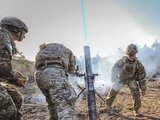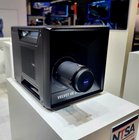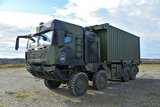South Korean defence industry demonstrates its tech prowess
Hanwha Aerospace has ambitious plans for the K9 155mm howitzer family, including an optionally manned K9A3 version. (Photo: Gordon Arthur)
The Republic of Korea Army (ROKA) has recently showcased numerous new items of kit including four new weapon systems: the Light Armed Helicopter from Korea Aerospace Industries (KAI); the containerised 20kW Cheongwang (Sky Light) Laser Anti-Air Weapon Block I from Hanwha Defense; Korean Tactical Surface-to-Surface Missile (KTSSM-I) Ure (Thunder) and 230mm unguided rocket from Hanwha Aerospace.
Meanwhile, the Barracuda 4x4 armoured vehicle, M18 57mm recoilless rifle and M45 Quadmount towed air defence system have all recently been retired by the force.
Many of the country’s defence firms were out in force at the inaugural Korea Army International Defence Industry
Access this article and other Decisive Edge Newsletter news content with a free basic account
You will also get one free Premium News article each week
Already have an account? Log in
More from Decisive Edge Newsletter
-
![Final two contenders for key £2 billion British Army training contract selected]()
Final two contenders for key £2 billion British Army training contract selected
The two remaining bidders for the flagship Army Collective Training Service (ACTS) contract will move on to the next 20-week phase to select the British Army's Strategic Training Partner.
-
![Cubic tailors mortar simulator for the US Army]()
Cubic tailors mortar simulator for the US Army
The company’s mortar trainer received improvements based on soldier’s feedback.
-
![I/ITSEC 2024: Zeiss introduces Velvet 4K SIM projector for night flight simulation]()
I/ITSEC 2024: Zeiss introduces Velvet 4K SIM projector for night flight simulation
The next-generation platform is motion-compatible and can be used in OTW and NVG applications.
-
![I/ITSEC 2024: Babcock Immersive Training Experience debuts in US]()
I/ITSEC 2024: Babcock Immersive Training Experience debuts in US
Named BITE, the system simulates the battlefield environment with multiple sensorial stimuli.
-
![What Saudi Arabia’s GCAP involvement could mean for the UK]()
What Saudi Arabia’s GCAP involvement could mean for the UK
Analysts have said that making space for the country in the sixth-gen fighter aircraft initiative could give the UK a chance to ease the financial burden of the aircraft’s development.
-
![Rheinmetall locks in $950 million purchase of US company to strengthen position]()
Rheinmetall locks in $950 million purchase of US company to strengthen position
Rheinmetall is working to open up the US market and the potential billions of dollars on offer. In order to get in the door it has purchased engineering company Loc Performance Products.
























